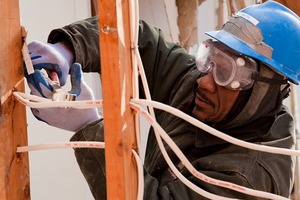A Second Chance for People and Things
By Kelly Medinger
03-15-2012
Second Chance uses human services grant to turn lives around
 52,000 labor hours created. $3.2 million consumer dollars saved. 11 million pounds of landfill waste diverted. And that was just in one year!
52,000 labor hours created. $3.2 million consumer dollars saved. 11 million pounds of landfill waste diverted. And that was just in one year!
Founded in 2001, Second Chance provides people, materials, and the environment with “a second chance.” The organization deconstructs buildings and homes, salvages usable materials, and then sells them to the public. The sales proceeds funnel into their workforce development program, which provides job training and placement to those with employment obstacles in the Baltimore region.
Turning Job Training Into Social Benefit
“It was hard to fully appreciate the social benefit of what we do until the first four guys graduated from our job training program,” Mark Foster, Founder and Executive Director, says with emotion in his eyes. “Then I saw what it actually meant – to watch four guys completely turn their lives around.”
Yet the turn is not an easy one. Job trainees must pass a rigorous two-week evaluation and qualifying period, which includes life and safety skills development, and then embark on 16 weeks of on-the-job technical instruction in how to use numerous types of power tools, hand tools, and equipment. Upon completion of the program, qualified trainees receive additional, specialized training in lead abatement and other hazardous materials removal and handling, as well as forklift operation. And those motivated to advance further can go on to receive certificates in carpentry, restoration, manufacturing, plumbing, electrical and masonry. In the end, trainees are placed in green jobs at companies such as Hirsch Electric and Waste Management System.
Expanding All Under One Roof
With funding from the Knott Foundation, Second Chance expanded the capacity of its job training program from 10 new trainees in 2010 to 30 in 2011, and they grew to reach more than 50 in 2012. Even more impressive are the outcomes from the program: During the grant period, for example, Second Chance boasted a 100% graduation rate. Every graduate was placed into a green job, and 97% remained in their jobs after one year. Moreover, ten workforce trainees were promoted, resulting in a combined annual pay increase of $52,000.
Second Chance’s new headquarters located at 1700 Ridgely Street in South Baltimore has brought the organization’s retail operations, job training program, and central office all under one roof – a meaningful achievement for the growing nonprofit and social enterprise. “The general public comes to Second Chance to shop in the warehouse for home furnishings, architectural salvage materials, building materials, and kitchen and bath elements,” shares Foster. “What they may not know is the whole story of our organization – what we accomplish for the universal good of us all.”
